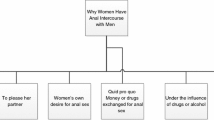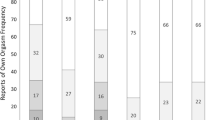Abstract
We asked 298 heterosexual Canadian university students about their definitions of the terms abstinence and having sex. For both terms, students were provided with a list of 17 sexual behaviors and indicated whether they would include each in their definition. The majority of both male and female students included activities that did not involve genital stimulation in their definition of sexual abstinence and did not include these activities in their definition of having sex. Conversely, most students did not include bidirectional sexual stimulation (penile–vaginal intercourse or penile–anal intercourse) in their definitions of sexual abstinence but did include them in their definitions of having sex. Students were quite mixed in whether activities involving unidirectional genital stimulation (e.g., oral sex, genital fondling) constituted abstinence, having sex, or neither abstinence nor having sex. However, they were more likely to see these behaviors as abstinent than as having sex. Students were more likely to rate a behavior as abstinence if orgasm did not occur. A canonical correlation analysis was used to examine the patterns of association between a number of predictors and inclusions of behaviors involving no genital stimulation, unidirectional stimulation, and bidirectional genital stimulation in abstinence definitions. The results indicated that male participants who were more involved with their religion and sexually conservative, less sexually experienced, and who had not received sexual health education at home were more likely to define bidirectional genital stimulation and less likely to define no genital stimulation and unidirectional sexual stimulation as sexual abstinence. The research and health promotion implications of these results are discussed.
Similar content being viewed by others
Notes
Canonical correlation analysis determines the linear combination of the variables in the predictor set that has the highest correlation with a linear combination of variables in the criterion set, and expresses this as a canonical correlation. Each linear combination is termed a canonical variate (Rc).
References
Blinn-Pike, L. (1999). Why abstinent adolescents report they have not had sex: Understanding sexually resilient youth. Family Relations, 48, 295–301.
Blinn-Pike, L., Berger, T. J., Hewett, J., & Oleson, J. (2004). Sexually abstinent adolescents: An 18-month follow-up. Journal of Adolescent Research, 19, 495–511.
Bogart, L. M., Cecil, H., Wagstaff, D. A., Pinkerton, S. D., & Abramson, P. R. (2000). Is it “sex?”: College students’ interpretations of sexual behavior terminology. Journal of Sex Research, 37, 108–116.
Bogart, L. M., Collins, R. L., Ellickson, P. L., & Klein, D. J. (2007). Association of sexual abstinence in adolescence with mental health in adulthood. Journal of Sex Research, 44, 290–298.
Canadian Federation for Sexual Health. (2007). Abstinence. Retrieved March 1, 2007 from http://www.ppfc/content.asp?articleid=305.
Carpenter, L. M. (2001). The ambiguity of “having sex”: The subjective experience of virginity loss in the United States. Journal of Sex Research, 38, 127–139.
Cecil, H., Bogart, L. M., Wagstaff, D. A., Pinkerton, S. D., & Abramson, P. R. (2002). Classifying a person as a sexual partner: The impact of contextual factors. Psychology and Health, 17, 221–234.
De Gaston, J. F., Weed, S., & Jensen, L. (1996). Understanding gender differences in adolescent sexuality. Adolescence, 31, 217–231.
Donnelly, J., Goldfarb, E., Duncan, D. F., Young, M., Eadie, C., & Casiglia, D. (1999). Self-esteem and sex attitudes as predictors of sexual abstinence by inner-city early adolescents. North American Journal of Psychology, 1, 205–212.
Gold, R., Karmiloff-Smith, A., Skinner, M., & Morton, J. (1992). Situational factors and thought processes associated with unprotected intercourse in heterosexual students. AIDS Care, 4, 305–323.
Goodson, P., Suther, S., Pruitt, B. E., & Wilson, K. (2003). Defining abstinence: Views of directors, instructors, and participants in abstinence-only-until-marriage programs in Texas. Journal of School Health, 73, 91–96.
Haglund, K. (2003). Sexually abstinent African American adolescent females’ descriptions of abstinence. Journal of Nursing Scholarship, 35, 231–236.
Horan, P. F., Phillips, J., & Hagan, N. E. (1998). What is abstinence?: The meaning of abstinence for college students. Journal of HIV/AIDS Prevention & Education for Adolescents and Children, 2(2), 51–66.
Hudson, W. W., & Murphy, G. J. (1998). Sexual Attitude Scale. In C. M. Davis, W. L. Yarber, R. Bauserman, G. Schreer, & S. L. Davis (Eds.), Handbook of sexuality-related measures (pp. 83–84). Thousand Oaks, CA: Sage.
Hudson, W. W., Murphy, G. J., & Nurius, P. S. (1983). A short-form scale to measure liberal vs. conservative orientation toward human sexual expression. Journal of Sex Research, 19, 258–272.
Hulton, L. J. (2001). The application of the transtheoretical model of change to adolescent sexual decision-making. Issues in Comprehensive Pediatric Nursing, 24, 95–115.
Hyde, J. S., DeLamater, J. D., & Byers, E. S. (2004). Understanding human sexuality: Third Canadian edition. Toronto: McGraw-Hill Ryerson.
Keller, M. L., Duerst, B. L., & Zimmerman, J. (1996). Adolescents’ views of sexual decision-making. IMAGE: Journal of Nursing Scholarship, 28, 125–130.
Lefkowitz, E. S., Gillen, M. M., & Shearer, C. L. (2004). Religiosity, sexual behaviors, and sexual attitudes during emerging adulthood. Journal of Sex Research, 41, 150–159.
Loewenson, P. R., Ireland, M., & Resnick, M. D. (2004). Primary and secondary sexual abstinence in high school students. Journal of Adolescent Sexual Health, 34, 209–215.
McConaghy, N. (1999). Unresolved issues in scientific sexology. Archives of Sexual Behavior, 28, 285–318.
National Consensus Process. (2006). The national consensus process on sexual health and responsible sexual behavior: Interim report. Atlanta, GA: Morehouse School of Medicine.
Newcomer, S. F., & Udry, J. R. (1985). Oral sex in an adolescent population. Archives of Sexual Behavior, 14, 41–46.
Oman, R. F., Vesely, S. K., Kegler, M., McLeroy, K., & Aspy, C. B. (2003). A youth development approach to profiling sexual abstinence. American Journal of Health Behavior, 27(Suppl. 1), S80–S93.
Ott, M. A., Pfeiffer, E. J., & Fortenberry, J. D. (2006). Perceptions of sexual abstinence among high-risk early and middle adolescents. Journal of Adolescent Health, 39, 192–198.
Paul, C., Fitzjohn, J., Eberthart-Phillips, J., Herbison, P., & Dickson, N. (2000). Sexual abstinence at age 21 in New Zealand: The importance of religion. Social Science & Medicine, 51, 1–10.
Pitts, M., & Rahman, M. (2001). Which behaviors constitute “having sex” among university students in the UK? Archives of Sexual Behavior, 30, 169–176.
Randall, H. E., & Byers, E. S. (2003). What is sex?: Students’ definitions of having sex, sexual partner, and unfaithful sexual behaviour. Canadian Journal of Human Sexuality, 12, 87–96.
Rasberry, C. N., & Goodson, P. (2007). Predictors of secondary abstinence in U.S. college undergraduates. Archives of Sexual Behavior. doi:10.1007/s10508-007-9214-z.
Richters, J., & Song, A. (1999). Australian university students agree with Clinton’s definition of sex. British Medical Journal, 318, 1011–1012.
Sanders, S. A., & Reinisch, J. M. (1999). Would you say you “had sex” if…? Journal of the American Medical Association, 281, 275–277.
Seal, D. W., & Palmer-Seal, D. A. (1996). Barriers to condom use and safer sex talk among college dating couples. Journal of Community & Applied Social Psychology, 6, 15–33.
Smith, T. E., Steen, J. A., Spaulding-Givens, J., & Schwendinger, A. (2003). Measurement in abstinence education. Evaluation & the Health Professions, 26, 180–205.
Sonfield, A., & Gold, R. B. (2001). States’ implementation of the Section 510 abstinence education program, FY 1999. Family Planning Perspectives, 33, 166–171.
Trenholm, C., Devaney, B., Fortson, K., Quay, L., Wheeler, J., & Clark, M. (2007). Impacts of four Title V section 510 abstinence education programs: Final report (MPR Ref. No. 8549-110). Princeton, NJ: Mathematica Policy Research Inc.
Acknowledgments
This research was conducted in partial fulfillment of the requirements for a B.A. (Honours) by the second and third authors under the supervision of the first author. The authors would particularly like to thank Lindsay Walsh and Susan Voyer for their help with data collection and data entry. We also appreciate the input into the design of this study of the Human Sexuality Research Group at the University of New Brunswick and Hilary Randall.
Author information
Authors and Affiliations
Corresponding author
Rights and permissions
About this article
Cite this article
Byers, E.S., Henderson, J. & Hobson, K.M. University Students’ Definitions of Sexual Abstinence and Having Sex. Arch Sex Behav 38, 665–674 (2009). https://doi.org/10.1007/s10508-007-9289-6
Received:
Revised:
Accepted:
Published:
Issue Date:
DOI: https://doi.org/10.1007/s10508-007-9289-6




